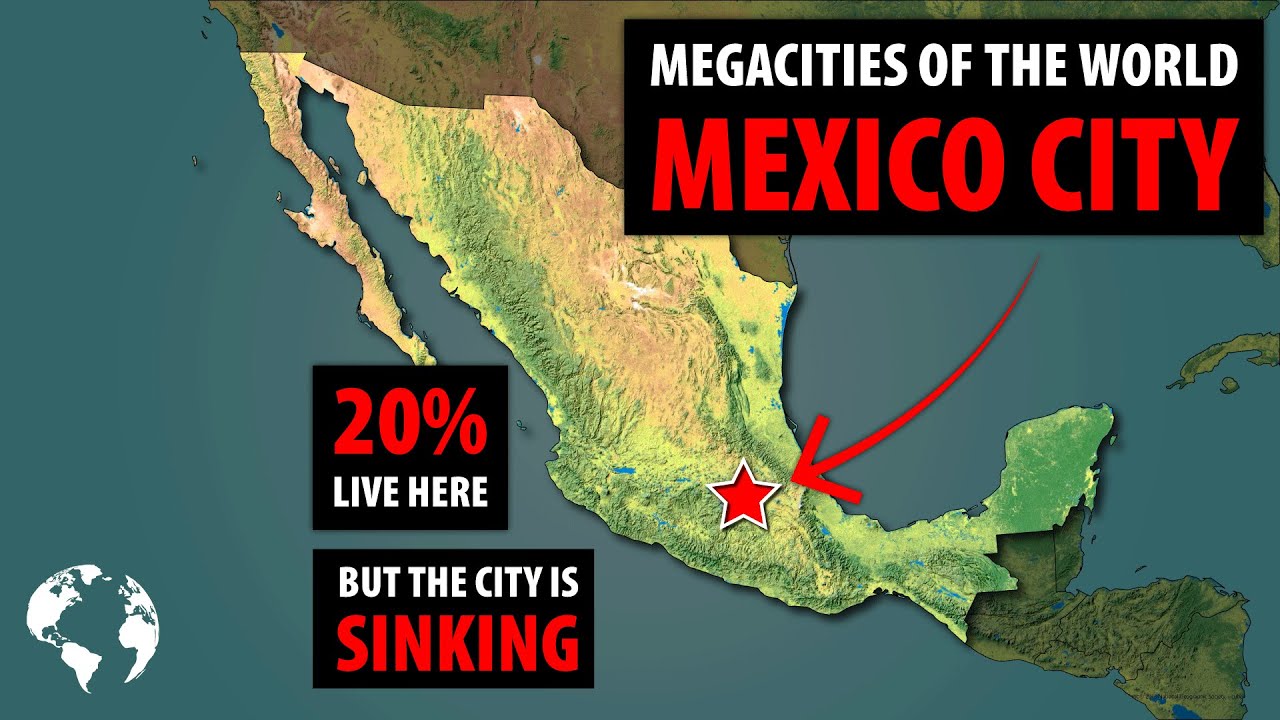The Critical Water Situation in Mexico City
Mexico City, the vibrant capital of Mexico, is facing a critical situation that affects both its residents and visitors: a severe water scarcity. Situated in a valley and having experienced rapid urban growth over the past decades, the city now confronts an unprecedented challenge in managing its water resources. The depletion of aquifers, upon which the city heavily relies, exacerbates this issue, leading to sinking land and compromised infrastructure.
The root of the crisis lies in the combination of geographical disadvantage and unsustainable water consumption patterns. Mexico City was built on an ancient lakebed, which complicates the situation. The draining of aquifers to supply the city’s water demand has resulted in subsidence, causing significant damage to buildings and roadways, and further complicating water distribution networks. This situation underscores the urgency for sustainable water management solutions that can address both immediate needs and future demands.
Efforts to mitigate the consequences of water scarcity have been implemented, including the importation of water from distant sources and rainwater harvesting initiatives. However, these measures have yet to fully resolve the problem. The need for comprehensive strategies that encompass conservation, efficient usage, and investment in infrastructure is apparent. Such strategies should aim to reduce the pressure on existing water sources while exploring alternative supply options.
The water crisis in Mexico City presents a complex challenge that demands concerted efforts from government, private sector, communities, and individuals. As travelers venture into this magnificent city, awareness and responsible water use can contribute to the broader efforts in addressing this critical issue. Engaging with the community and participating in sustainable practices are ways in which visitors can have a positive impact. Through collaborative and innovative approaches, we can hope to find viable solutions to the water scarcity problem that Mexico City faces.
Understanding Mexico City’s Water Extraction Methods
Mexico City, with a booming population and a location in a high-altitude basin, faces significant challenges in water extraction and management. The city’s approach to water extraction is not only a marvel of modern engineering but also a testament to its resilience and innovation in the face of geographical and environmental hurdles.
One of the primary methods of water extraction in Mexico City involves tapping into the deep aquifer system beneath the Valley of Mexico. This method requires drilling deep wells to access the underground reservoirs that hold fresh water. These aquifers are the city’s lifeline, providing a significant portion of the water required to sustain its vast population. However, excessive reliance on aquifer extraction has led to subsidence issues, with some areas of the city sinking as much as nine inches per year.
To combat the subsidence and depletion of the aquifers, Mexico City has also embraced the use of rainwater harvesting. This method captures rainfall using large collection systems installed on buildings and in public spaces. The collected water is then treated and reused, alleviating the pressure on the city’s aquifers and reducing the city’s overall water import needs.
Another key element in Mexico City’s water extraction toolkit is the importation of water from distant sources. The city has constructed elaborate systems of canals and pipelines to transport water from rivers and lakes located hundreds of kilometers away. This water is then processed in treatment plants before being distributed to the city. Though effective, this method is costly and poses significant environmental and political challenges.
In addition to these methods, Mexico City is also exploring cutting-edge technologies and sustainable practices to enhance its water extraction and conservation efforts. Innovations such as wastewater recycling and advanced treatment processes are being implemented to make the city’s water management system more efficient and sustainable. These efforts reflect Mexico City’s commitment to overcoming its water challenges and ensuring a reliable water supply for its inhabitants.
Estimating the Timeframe for Replenishing Mexico City’s Water Supply
Mexico City, a sprawling urban landscape, is facing a considerable challenge in managing its water supply. As this issue becomes increasingly critical, understanding the timeframe for replenishing the city’s water supply is paramount for both residents and visitors. This effort requires a detailed look into conservation efforts, technological advancements, and policy implementations geared towards water sustainability in Mexico’s capital.
Conservation Measures and Public Awareness play a significant role in the timeframe for water replenishment. The city has initiated various water-saving campaigns aimed at reducing consumption in both households and businesses. These efforts are crucial in extending the city’s current water supply while searching for long-term solutions. Public cooperation and behavioral change towards water usage can significantly dictate the pace at which the city’s water supply is replenished.
Technological advancements in water management are also critical in determining the timeline for Mexico City’s water replenishment. Innovations such as rainwater harvesting systems, wastewater treatment for reuse, and efficient irrigation technologies are being implemented. These technologies have the potential to considerably reduce the strain on existing water resources, thereby aiding in quicker replenishment of the city’s water supply.
Policy implementation and governmental initiatives are further pivotal components. The government’s role in enforcing water conservation laws, managing water allocation, and investing in sustainable water infrastructure cannot be understated. Effective policies that prioritize water sustainability can greatly influence the timeframe for replenishing Mexico City’s water supply. The government’s commitment to addressing this issue head-on will be a determining factor in the success of these endeavors.
Lastly, climate change has an undeniable impact on the timetable for water replenishment in Mexico City. The effects of global warming contribute to altered rainfall patterns, affecting the replenishment rates of natural water sources. Addressing climate change, therefore, becomes inseparable from the efforts to replenish Mexico City’s water supply. The collaboration between global and local initiatives aimed at counteracting these changes will play a crucial role in determining the future state of water availability in the city.
Understanding the complexity and interdependence of these factors is essential in estimating the timeframe for replenishing Mexico City’s water supply. While immediate actions are being taken, the journey towards a fully replenished water supply is intricate and requires continuous effort from all stakeholders involved.
The Long-term Impact of Water Extraction on Mexico City
Mexico City, a sprawling urban metropolis, faces a significant environmental challenge that traces back centuries. The issue of water extraction has been critical since the city’s founding, largely because it was built on the ancient Lake Texcoco. Over the years, the demand for fresh water in this growing city has led to extensive groundwater extraction. This process, however necessary for supporting the city’s population, has led to a range of long-term impacts that threaten the sustainability and infrastructure of the area.
One major consequence of excessive water extraction is land subsidence. Mexico City is sinking at an alarming rate of up to 12 inches (30 cm) a year in some areas, significantly more than any major urban area globally. This subsidence has serious implications for buildings and roads, causing structural damages that are both dangerous and costly to repair. The sinking is uneven, leading to further complications in the city’s infrastructure, including ruptured water pipes and disrupted sewage systems. These physical damages not only pose a threat to the city’s historical architecture but also to its modern-day functionality.
Another critical issue is the depletion of aquifers, which threatens the city’s long-term water supply. As the water levels drop, the remaining water becomes more difficult and expensive to extract. This not only poses a risk to the future availability of water but also leads to a degradation of water quality. Contaminants concentrate in lower volumes of water, increasing the risk of health issues among the population who rely on this water for drinking and other domestic uses.
The ecological balance of the surrounding areas is also at risk. The extraction of groundwater affects the natural replenishment of lakes, rivers, and wetlands, leading to a loss of biodiversity. Habitats for various species are shrinking or disappearing, disrupting ecosystems. Furthermore, the diminished water sources lead to increased competition among agricultural, urban, and industrial users, further stressing the already limited resources.
Understanding these impacts is crucial for planning and implementing measures that can mitigate the long-term effects of water extraction on Mexico City. While the situation is complex, efforts to reduce water consumption, repair and upgrade infrastructure, and invest in sustainable water resources are vital steps towards addressing these challenges.
Sustainable Solutions for Mexico City’s Water Crisis
Mexico City, one of the largest and most populous cities in the world, faces significant water scarcity issues. The problem stems from a combination of factors, including overpopulation, over-extraction of groundwater, and inadequate infrastructure. However, innovative sustainable solutions are being explored and implemented to address this crisis, ensuring that both residents and visitors can enjoy the city’s attractions without exacerbating the water scarcity situation.
Firstly, rainwater harvesting systems have emerged as a viable option. By capturing and storing rainwater, these systems provide an alternative water source for non-potable uses, such as irrigation for parks and green spaces, or for use in toilets. This method not only reduces the demand on the city’s overburdened water supply but also mitigates the risk of flooding during the rainy season. Public and private initiatives are increasingly installing these systems across buildings and homes, showcasing a community-driven approach to water conservation.
Additionally, the revitalization of ancient water management techniques, such as the chinampas in Xochimilco, provides both cultural and environmental benefits. These floating gardens, a method dating back to the Aztecs, offer a sustainable way of agriculture that doesn’t stress the city’s water resources. Efforts to preserve and expand these practices play a crucial role in educating the public about traditional methods of water conservation, aligning historical preservation with modern sustainability efforts. These strategies, among others, highlight a path forward for Mexico City in its quest to resolve its water crisis while promoting eco-friendly tourism and adventure opportunities.


